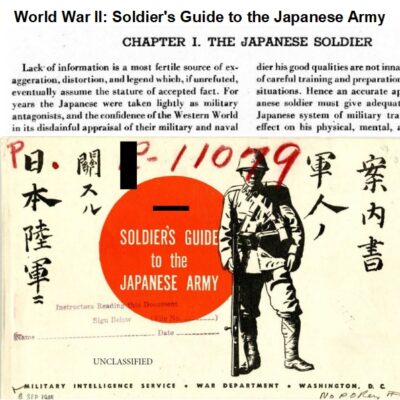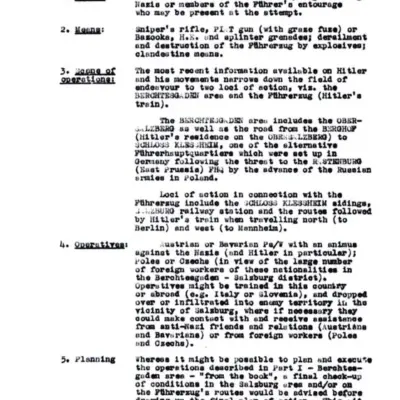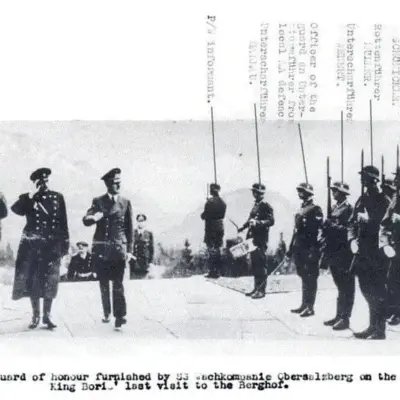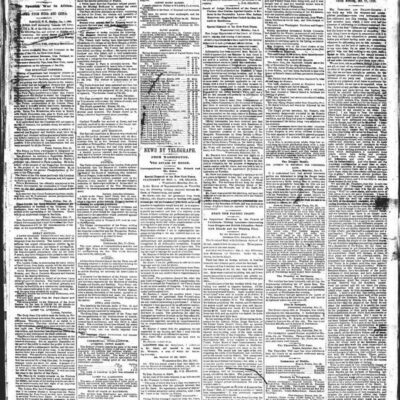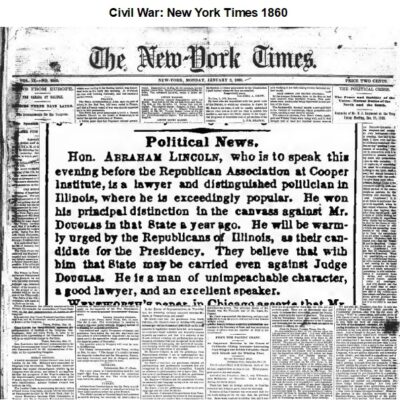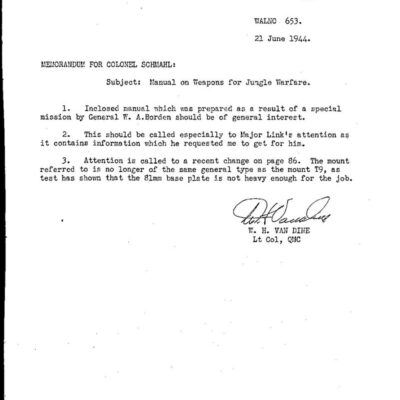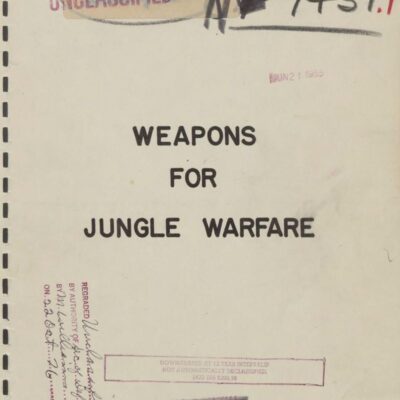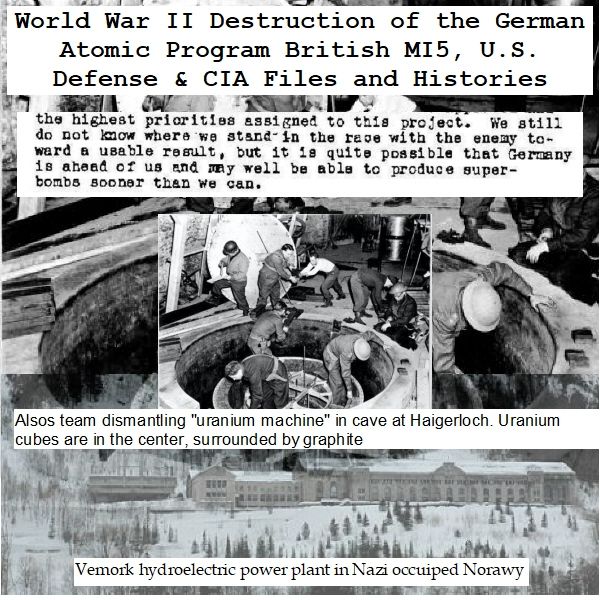
WWII Destruction of the German Atomic Program British Intel MI5, US Army & CIA Files
$19.50
Description
Disrupting Hitler’s Bomb: The Norsk Hydro Sabotage
Timeline of Events: Destruction of the German Atomic Program
This timeline focuses on the events detailed in the provided sources related to the Allied efforts to disrupt the German nuclear program, particularly targeting the heavy water production at Norsk Hydro in Norway.
1940:
- June: Germany occupies Norway after the Norwegian Campaign. Knut Haugland, a radio engineer in the Norwegian Army, joins the Norwegian Resistance while working at a radio factory in Oslo.
1942:
- Mid-1942: Knut Haugland is arrested by the Statspolitiet (Norwegian puppet government’s state police) but escapes and flees to England.
- October 18: Operation Grouse is launched. Knut Haugland and three other Norwegian commandos parachute into the Hardanger Plateau in Norway to prepare for the destruction of the Norsk Hydro heavy water plant.
- November (approx.): The second phase of Operation Grouse, involving two gliders carrying more commandos, fails. Both gliders crash, and the survivors are captured, tortured, and executed by the Germans.
- October 1942 – February 1943: Haugland and the remaining three Grouse commandos survive the harsh Norwegian winter on the plateau, facing food scarcity and evading German patrols. Haugland manages to establish radio contact with Britain using a modified radio.
1943:
- February 27: Operation Gunnerside is launched. Six additional Norwegian commandos are dropped into Norway to reinforce the Grouse team.
- Night of February 27-28: The combined team of commandos successfully infiltrates the heavily guarded Norsk Hydro plant at Vemork. They bypass defenses, including mines and floodlights around the single-span bridge, by descending into a ravine, crossing a freezing river, and climbing a steep hill. They enter the plant through a cable tunnel and a window.
- February 28: The commandos plant explosives in the heavy water production cells and detonate them, effectively halting production. They then successfully evade the German forces.
- Post-Gunnerside: Three thousand German soldiers are tasked with hunting down the commandos. Four members ski hundreds of miles to Sweden. Haugland and others remain in Norway for resistance work. Haugland hides in the mountains for two months before returning to Oslo.
- Throughout 1943: Knut Haugland twice makes sea crossings between Norway and Scotland for training and supplies.
- November: Knut Haugland is captured by the Gestapo again but manages to escape.
- 1943 (Ongoing): Allied intelligence, including British MI5, U.S. intelligence (eventually involving the OSS and later the CIA), monitors the German atomic program and assesses the impact of the destruction of the heavy water supply. The Manhattan Project, under the direction of Leslie Groves, is aware of the Norsk Hydro incident. Vannevar Bush and his office (OSRD) collect intelligence on German atomic efforts and report to President Roosevelt.
1944:
- April 1: Knut Haugland is located in a Norwegian hospital with radio equipment. Despite the surrounding German troops, he shoots his way out and evades capture.
- Post-April 1: Knut Haugland returns to England and remains there for the rest of World War II.
- Throughout the War: The Alsos Mission is active, a U.S. effort to discover enemy scientific developments, including information related to the German atomic program. George L. Harrison and Harvey H. Bundy, special assistants to Secretary of War Stimson, handle intelligence reports, including those about German interest in French atomic research.
Post-War:
- November 1945: William E. Colby (future Director of the CIA) writes an account of OSS sabotage operations in Norway, including Operation Gunnerside, though it is not immediately published.
- Later: Claus Helberg, a member of the Gunnerside team, writes an article about the “Vemork Action” for the CIA’s “Studies in Intelligence.”
- 2002: Charles R. Loeber’s book “Building the Bombs: A History of the Nuclear Weapons Complex” discusses the German atomic program and the Allied efforts against it.
- 2010: Major Frode Kristoffersen of the Norwegian Army writes a Marine Corps Command and Staff College study analyzing Operations Grouse and Gunnerside.
- 2018: Major Kyle J. Thompson (Naval Postgraduate School thesis) and MAJ Tanner C. Garrett (US Army Command and General Staff College monograph) both use Operation Gunnerside as a case study in their respective works on special operations forces and counterproliferation/mission command.
Cast of Characters and Brief Bios:
- Knut Haugland: A Norwegian radio engineer and member of the Norwegian Resistance. Codenamed N.7 and Agent Primus. Played a crucial role in both Operation Grouse and Operation Gunnerside, including establishing radio contact and participating in the sabotage of the Norsk Hydro plant. He endured harsh conditions, escaped the Gestapo twice, and received high military honors from both Norway and Britain.
- Leslie R. Groves, Jr.: A Major General in the U.S. Army and the director of the Manhattan Project, the Allied effort to develop the atomic bomb. He was aware of and concerned by the German atomic program and the efforts to disrupt it, including the Norsk Hydro incident.
- Vannevar Bush: Director of the U.S. Office of Scientific Research and Development (OSRD) from 1941 to 1946. He oversaw American scientific research and development during the war, including the early stages of the atomic program. He collected and analyzed intelligence on the German atomic program and reported to President Roosevelt.
- George L. Harrison: A special assistant to U.S. Secretary of War Henry L. Stimson. He was involved in handling intelligence reports related to potential German atomic research and their interactions with scientists in occupied territories.
- Harvey H. Bundy: Another special assistant to Secretary of War Henry L. Stimson, working alongside George L. Harrison on intelligence matters concerning the war effort, potentially including the German atomic program.
- Claus Helberg: A member of the Norwegian sabotage team that carried out Operation Gunnerside. He later wrote an article for the CIA’s “Studies in Intelligence” detailing the “Vemork Action.”
- William E. Colby: An officer in the Office of Strategic Services (OSS) during World War II who was involved in sabotage operations in Norway. He later became the Director of the Central Intelligence Agency (CIA) from 1973 to 1976. He wrote a memoir about OSS operations in Norway, which included Operation Gunnerside, though it was not published immediately.
- Charles R. Loeber: An author from Sandia National Laboratories who wrote “Building the Bombs: A History of the Nuclear Weapons Complex.” His book covers the German atomic bomb program and the Allied efforts to counter it.
- Frode Kristoffersen: A Major in the Norwegian Army who authored a Master of Military Studies research paper for the United States Marine Corps Command and Staff College analyzing Operations Gunnerside and Grouse.
- Kyle J. Thompson: A Major who wrote a thesis for the Naval Postgraduate School examining the role of Special Operations Forces in counterproliferation, using Operation Gunnerside as a key historical case study.
- Tanner C. Garrett: A Major in the U.S. Army who authored a monograph for the School of Advanced Military Studies, US Army Command and General Staff College, using Operation Gunnerside as a case study to examine mission command principles in special operations
WWII Destruction of the German Atomic Program British Intel MI5, US Army & CIA Files
620 pages of documents and histories dealing with the German nuclear program and its destruction through Operation Gunnerside. Includes intelligence after Gunnerside to gauge the possibility of a residual German atomic program.
Operation Gunnerside ended what the allies suspected to be a German nuclear bomb project. The 1943 destruction of the Nordsk Hydro plant in Telemark, Norway ended the manufacturing of heavy water for use in German projects. Heavy water can be used in a certain type of reactor, in which plutonium can be bred from natural uranium.
This action is well chronicled in the MI5 files of Knut Haugland.
Super Agent Knut Haugland Also Known as N.7 and Agent Primus – British Intelligence Files
102 pages of British Intelligence MI5 – Special Operations Executive files on Knut Magne Haugland. Knut Haugland (September 23, 1917 – December 25, 2009) was also known by the codenames N.7 and Primus. Haugland is best known for his role in Operation Gunnerside.
The World War II era files contain reports on Haugland’s special operations training, his conduct and accounts of his two escapes from the grasp of the Gestapo. The files contain personal letters from Haugland and his report on the technical aspects of Operation Grouse and Operation Gunnerside.
Haugland was born on September 23, 1917 in Rjukan, Telemark, Norway. He became a radio engineer in the Norwegian Army. In June 1940, Germany occupied Norway after it was defeated in the Norwegian Campaign. Haugland went to work at a radio factory in Oslo and joined the Norwegian Resistance. The German occupation Norwegian puppet government’s state police, the Statspolitiet, arrested Haugland in 1942. He escaped from custody and fled to England. He spent the next two years training in England and caring out missions in Norway.
The British lead the way in ending the German supply of heavy water from the Nordsk Hydro pant. Operation Grouse was launched on October 18, 1942, when Haugland and three commandos parachuted into Norway. The second phase of the operation called for two gliders to bring in more commandos. Both gliders missed their landing spot and crashed. The survivors were captured, tortured and then executed by the Germans.
Haugland and the three others spent the next 4 months trying to survive the winter. When they could not capture a reindeer, they ate oatmeal mixed with moss and lichen that they scraped from rocks. Haugland was able to communicate back to Britain using a radio he had to modify with a car battery and stolen fishing rods.
The British launched Operation Gunnerside on February 27, 1943 by sending in 6 more commandos. The Germans had increased defenses around the plant. The plant was now secured by mines and floodlights and was only accessible by a single-span bridge traversing a deep ravine. The commandos lowered themselves into the ravine and waded through a freezing cold river. They then climbed up a steep hill and entered the plant grounds though a cable tunnel, then entered the plant through a window. They planted explosives that blew-up the heavy water producing cells.
Three-thousand German soldiers were tasked with hunting down the commandos. Four members skied hundreds of miles to get to Sweden. Haugland and the others remained in Norway to do resistance work. Haugland hide in the mountains for two months before going back to Oslo.
Afterwards, he twice made sea crossings to Scotland and back for training and supplies. In November 1943, he was captured by the Gestapo and escaped.
On April 1, 1944 he was located in a Norwegian hospital, where he had set up radio equipment. Despite the fact that the hospital was surrounded by
German troops, Haugland was able to shoot his way out of the hospital and evade capture. Haugland returned to England, where he remained for the rest of World War II.
Haugland was twice awarded Norway’s highest decoration for military heroism, the War Cross with Sword, once in 1943 and again in 1944. The British awarded him the Distinguished Service Order and the Military Medal.
Leslie Groves Manhattan Project “TOP SECRET” Correspondences
Major General Leslie R. Groves, Jr. was the director of the Manhattan Project. 116-pages of papers dealing with the Norsk Hydro incident, bombing of Norwegian heavy water plant in 1943 and the Alsos Mission in Germany. The Alsos Mission was an organized effort by a team of United States military, scientific, and intelligence personnel to discover enemy scientific developments during World War II.
Vannevar Bush Papers/Correspondences
Vannevar Bush was director of the Office of Scientific Research and Development (OSRD, 1941-46). Files contain 166 pages of documents related to intelligence on German’s atomic program.
Contains reports to and record of conferences with the President Roosevelt [1942-44]. Includes letters to President Roosevelt on the development of the U.S. and British programs and speculations on the German program. Bush’s papers include reports summarizing information intercepted by intelligence sources on Germany’s efforts toward manufacturing an atom bomb.
George L. Harrison and Harvey H. Bundy Papers
George L. Harrison and Harvey H. Bundy were special assistants to Secretary of War Henry L. Stimson. The selected intelligence reports cover visits to French scientists in occupied France by German scientists who visited research labs during the occupation of France with probable interest in atomic research.
CIA Studies in Intelligence Article – “A Classic Act of Sabotage: The Vemork Action.” by Claus Helberg.
An article from the from the Central Intelligence Agency’s (CIA) professional journal, “Studies in Intelligence.” Written by Claus Helberg a member of the Norwegian sabotage team.
OSS Operations in Norway Skis and Daggers by William E. Colby
Material related to the tactics used in Operation Gunnerside. A write up in the Winter 1999/2000 issue of the CIA’s professional journal “Studies in Intelligence,” of some old CIA files, a CIA historian chanced upon. They contained an account by Maj. William E. Colby, who would become Director of the CIA (September 4, 1973 – January 30, 1976) of behind-the lines OSS sabotage operations in Norway during World War II. In November 1945, the War Department’s Bureau of Public Relations posed no objection to the article’s publication. There is no record, however, that the article was ever published. The first page of the memoir is missing. As Major Colby begins his story, he and his team are being flown to their drop site in Norway. “The Office of Strategic Services trained the Norwegian Special Operations Group for cutthroat missions behind German lines in Norway,” wrote the future Director of Central Intelligence.
Excerpt from Building the Bombs: A History of the Nuclear Weapons Complex (2002)
An excerpt from the book Building the Bombs: A History of the Nuclear Weapons Complex by Sandia National Laboratories’ Charles R. Loeber, covering the German Atomic Bomb Program. Topics include Germany’s head start in atomic research, Alsos Project, Farm Hall, poor leadership of the German program, lack of desire by many German scientists to build a bomb and technical errors by the program.
United States Marine Corps Command and Staff College Study – Operations GUNNERSIDE and GROUSE – Special Operations during World War II Against the German Controlled Heavy Water Plant in Norway. (2010)
Marine Corps Command and Staff College Master of Military Studies Research paper by Frode Kristoffersen, Major, Norwegian Army.
Abstract: Operations Grouse and Gunnerside achieved an outcome of strategic importance when they destroyed the heavy water production at Rjukan in February 1943. The operations were a success due to their execution by Special Operations Forces, which demonstrated that a small, select group of individuals with specialized training and thorough preparation could succeed where a conventional force could not.
Special Operations Forces And Counterproliferation: Lessons From History (2018)
A Naval Postgraduate School thesis by Major Kyle J. Thompson. Much attention id given to Operation Gunnerside in this study.
Abstract: Considering the significant consequences of nuclear proliferation, this thesis asserts that historical case studies yield lessons learned that inform the suitability of Special Operations Forces’ (SOF) role within counterproliferation efforts that can help guide development of SOF counterproliferation-related missions.
Mission Command Principles Applied to Paramilitary Forces in Europe During the Second World War (2018)
A School of Advanced Military Studies US Army Command and General Staff College monograph by MAJ Tanner C. Garrett, US Army. This monograph examines how Special Operations Forces exercise mission command (MC) as a philosophy in a denied environment against a peer adversary. Includes Operation Gunnerside as one of its case studies.







